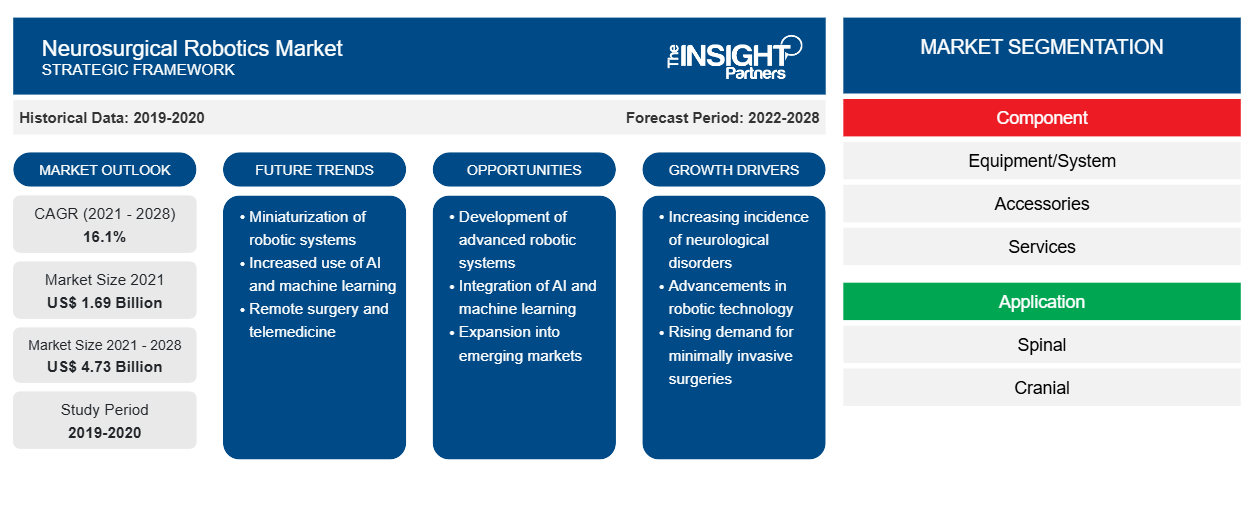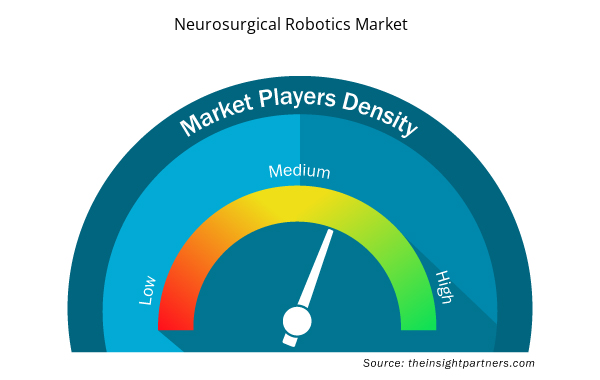The neurosurgical robotics market is expected to grow from US$ 1,691.02 million in 2021 to US$ 4,729.86 million by 2028. It is estimated to grow at a CAGR of 16.1% from 2022 to 2028.
A robot is an automatic mechanical device often resembling a human or animal. Modern robots are usually electro-mechanical machines guided by a computer program or electronic circuitry. Robots can be autonomous or semi-autonomous and range from humanoids such as Honda's Advanced Step in Innovative Mobility (ASIMO) and TOSY's TOSY Ping Pong Playing Robot (TOPIO) to industrial robots, collectively programmed swarm robots, and even microscopic nanorobots. Over the last 20 years, neurosurgical robots have been increasingly assisting in neurosurgical procedures. In recent years, neurosurgical robots have been developed to perform various procedures. Public demand is informing the direction of neurosurgery and placing greater pressure on neurosurgeons to use neurosurgical robots. The increasing diversity and sophistication of neurosurgical robots have received ethical scrutiny due to the surgical complications that may arise as well as the role of robots in the future.
The report offers insights and in-depth analysis of the global neurosurgical robotics market, emphasizing various parameters, including market trends, technological advancements, market dynamics, and competitive landscape analysis of global leading market players. It also includes the impact of the COVID-19 pandemic on the market across all regions. The overall COVID-19 impact on the neurosurgical robotics market was mixed; hence, the market is still gaining traction and is expected to grow in the coming years. The health care systems were overburdened, and the delivery of medical care to all patients has become a challenge in the region. In addition, the medical device industry was also facing the undesirable impact of this pandemic. As the COVID-19 pandemic continued to unfold, medical device companies found difficulties managing their operations. Many companies of neurosurgical robotics had their business operations in the USand businesses were adversely affected by the effects of a widespread outbreak of COVID-19. However, after the pandemic restrictions normalized, the volume of surgical procedures returned to normal levels. Gradually hospitals started resuming elective procedures as the COVID-19 recovery rate was increasing the demand for medical equipment like neurosurgical robots.
Customize This Report To Suit Your Requirement
You will get customization on any report - free of charge - including parts of this report, or country-level analysis, Excel Data pack, as well as avail great offers and discounts for start-ups & universities
Neurosurgical Robotics Market: Strategic Insights

- Get Top Key Market Trends of this report.This FREE sample will include data analysis, ranging from market trends to estimates and forecasts.
Customize This Report To Suit Your Requirement
You will get customization on any report - free of charge - including parts of this report, or country-level analysis, Excel Data pack, as well as avail great offers and discounts for start-ups & universities
Neurosurgical Robotics Market: Strategic Insights

- Get Top Key Market Trends of this report.This FREE sample will include data analysis, ranging from market trends to estimates and forecasts.
Geography-Based Insights
By geography, the global neurosurgical robotics market is segmented into North America (the US, Canada, and Mexico), Europe (France, Germany, the UK, Spain, Russia, Italy, and the Rest of Europe), Asia Pacific (China, India, Japan, Australia, South Korea, Kazakhstan, and the Rest of APAC), the Middle East & Africa (Saudi Arabia, the UAE, South Africa, and the Rest of the MEA), and South & Central America (Brazil, Argentina, and the Rest of South & Central America).
Market Insights
Rise in Number of Neurosurgical Procedures
The growing prevalence of neurological disorders, including epilepsy, Parkinson’s disease, head injury, brain tumors, brain stroke, and hydrocephalus, raises the need for neurosurgeries. Also, several subspecialties of neurosurgery, such as pediatric neurosurgery, functional neurosurgery, neurovascular surgery, traumatology, skull-base surgery, and spinal surgery, are among the most technical and skilled areas of surgery.
According to an article entitled “Emphasizing the Role of Neurosurgery Within Global Health and National Health Systems” published in Frontiers Media S.A. in 2021, due to the increasing incidence of traumatic brain injury (TBI) and hydrocephalus, 22.6 million individuals worldwide need neurological care annually. Among these patients, 13.8 million individuals require neurosurgery. As per the data published by the Centers for Disease Control and Prevention (CDC), the US recorded ~223,135 TBI-related hospitalizations in 2019 and 64,362 TBI-related deaths in 2020. Also, as per an article published in 2022 in The Lancet entitled “The future research path of traumatic brain injury, " more than 27 million new cases of TBI are reported worldwide every year. TBI can be treated by neurosurgical procedures. Therefore, the rising cases of TBI due to several factors, including falls, sports injuries, road accidents, domestic violence, and military incidents, propel the demand for neurosurgical procedures.
According to World Health Organization (WHO) data published in June 2022, ~50 million people have epilepsy across the world, and it is one of the most common neurological diseases. Nearly 80% of epilepsy patients are in low- and middle-income countries. Additionally, an estimated 5 million people are diagnosed with epilepsy each year. The patients who poorly respond to drug treatment undergo surgery. Therefore, the growing incidence of epilepsy propels the need for neurosurgical procedures. Thus, an increase in the number of neurosurgeries drives the growth of the neurosurgical robotics market.
Component-Based Insights
Based on component, the global neurosurgical robotics market is segmented into equipment, accessories, and services. In 2021, the accessories segment accounted for the largest market share. However, the services segment is anticipated to register the highest CAGR in the market from 2022 to 2028.
Application-Based Insights
Based on application, the global neurosurgical robotics market is bifurcated into spinal and cranial. The spinal segment held a larger market share in 2021 and is expected to register a faster CAGR during the forecast period.
Neurosurgical Robotics Market Regional Insights
Neurosurgical Robotics Market Regional Insights
The regional trends and factors influencing the Neurosurgical Robotics Market throughout the forecast period have been thoroughly explained by the analysts at Insight Partners. This section also discusses Neurosurgical Robotics Market segments and geography across North America, Europe, Asia Pacific, Middle East and Africa, and South and Central America.

- Get the Regional Specific Data for Neurosurgical Robotics Market
Neurosurgical Robotics Market Report Scope
| Report Attribute | Details |
|---|---|
| Market size in 2021 | US$ 1.69 Billion |
| Market Size by 2028 | US$ 4.73 Billion |
| Global CAGR (2021 - 2028) | 16.1% |
| Historical Data | 2019-2020 |
| Forecast period | 2022-2028 |
| Segments Covered |
By Component
|
| Regions and Countries Covered | North America
|
| Market leaders and key company profiles |
Neurosurgical Robotics Market Players Density: Understanding Its Impact on Business Dynamics
The Neurosurgical Robotics Market market is growing rapidly, driven by increasing end-user demand due to factors such as evolving consumer preferences, technological advancements, and greater awareness of the product's benefits. As demand rises, businesses are expanding their offerings, innovating to meet consumer needs, and capitalizing on emerging trends, which further fuels market growth.
Market players density refers to the distribution of firms or companies operating within a particular market or industry. It indicates how many competitors (market players) are present in a given market space relative to its size or total market value.
Major Companies operating in the Neurosurgical Robotics Market are:
- Brainlab AG
- Medtronic
- Renishaw plc
- Zimmer Biomet
- Globus Medical, Inc.
Disclaimer: The companies listed above are not ranked in any particular order.

- Get the Neurosurgical Robotics Market top key players overview
End User-Based Insights
Based on end users, the global neurosurgical robotics market is segmented into hospitals, specialty centers, and others. The hospitals segment held the largest market share in 2021. The same segment is expected to register the highest CAGR in the market from 2022 to 2028.
The global neurosurgical robotics market players take up organic strategies, including product launch and expansion, to expand their footprint and product portfolio worldwide and meet the growing demand. The key players in the market are Globus Medical, Inc., Renishaw plc, Accuray Incorporated, NuVasive, Inc, Brainlab AG, Zimmer Biomet, Synaptive Medical, Inc., Medtronic, Brain Navi Biotechnology Co., Ltd., B. Braun Melsungen AG.
- Historical Analysis (2 Years), Base Year, Forecast (7 Years) with CAGR
- PEST and SWOT Analysis
- Market Size Value / Volume - Global, Regional, Country
- Industry and Competitive Landscape
- Excel Dataset


- Medical Second Opinion Market
- Military Rubber Tracks Market
- Small Molecule Drug Discovery Market
- Glycomics Market
- Frozen Potato Market
- Fill Finish Manufacturing Market
- Water Pipeline Leak Detection System Market
- Biopharmaceutical Tubing Market
- Queue Management System Market
- Micro-Surgical Robot Market

Report Coverage
Revenue forecast, Company Analysis, Industry landscape, Growth factors, and Trends

Segment Covered
Component, Application, Surgery Type, and End Users

Regional Scope
North America, Europe, Asia Pacific, Middle East & Africa, South & Central America

Country Scope
Argentina, Australia, Brazil, Canada, China, France, Germany, India, Italy, Japan, Kazakhstan, Mexico, Russian Federation, Saudi Arabia, South Africa, South Korea, Spain, United Arab Emirates, United Kingdom, United States
Frequently Asked Questions
Brainlab AG; Medtronic; Renishaw plc; Zimmer Biomet; Globus Medical, Inc.; Synaptive Medical, Inc.; NuVasive, Inc.; Accuray Incorporated; Brain Navi Biotechnology Co., Ltd.; and B. Braun Melsungen AG are among the leading companies operating in the neurosurgical robotics market.
The minimal invasive segment dominated the global neurosurgical robotics market and accounted for the largest market share in 2021.
Based on application, spinal segment took the forefront lead in the worldwide market by accounting largest share in 2021 and is expected to continue to do so till the forecast period.
Rise in number of neurosurgical procedures and advantages of neurosurgical robots encourage key players to develop innovative products are the most significant factors responsible for the overall market growth.
Based on component, equipment/systems segment took the forefront lead in the worldwide market by accounting largest share in 2021 and is expected to continue to do so till the forecast period.
Trends and growth analysis reports related to Life Sciences : READ MORE..
The List of Companies - Neurosurgical Robotics Market
- Brainlab AG
- Medtronic
- Renishaw plc
- Zimmer Biomet
- Globus Medical, Inc.
- Synaptive Medical, Inc.
- NuVasive, Inc.
- Accuray Incorporated
- Brain Navi Biotechnology Co., Ltd.
- B. Braun Melsungen AG

 Get Free Sample For
Get Free Sample For